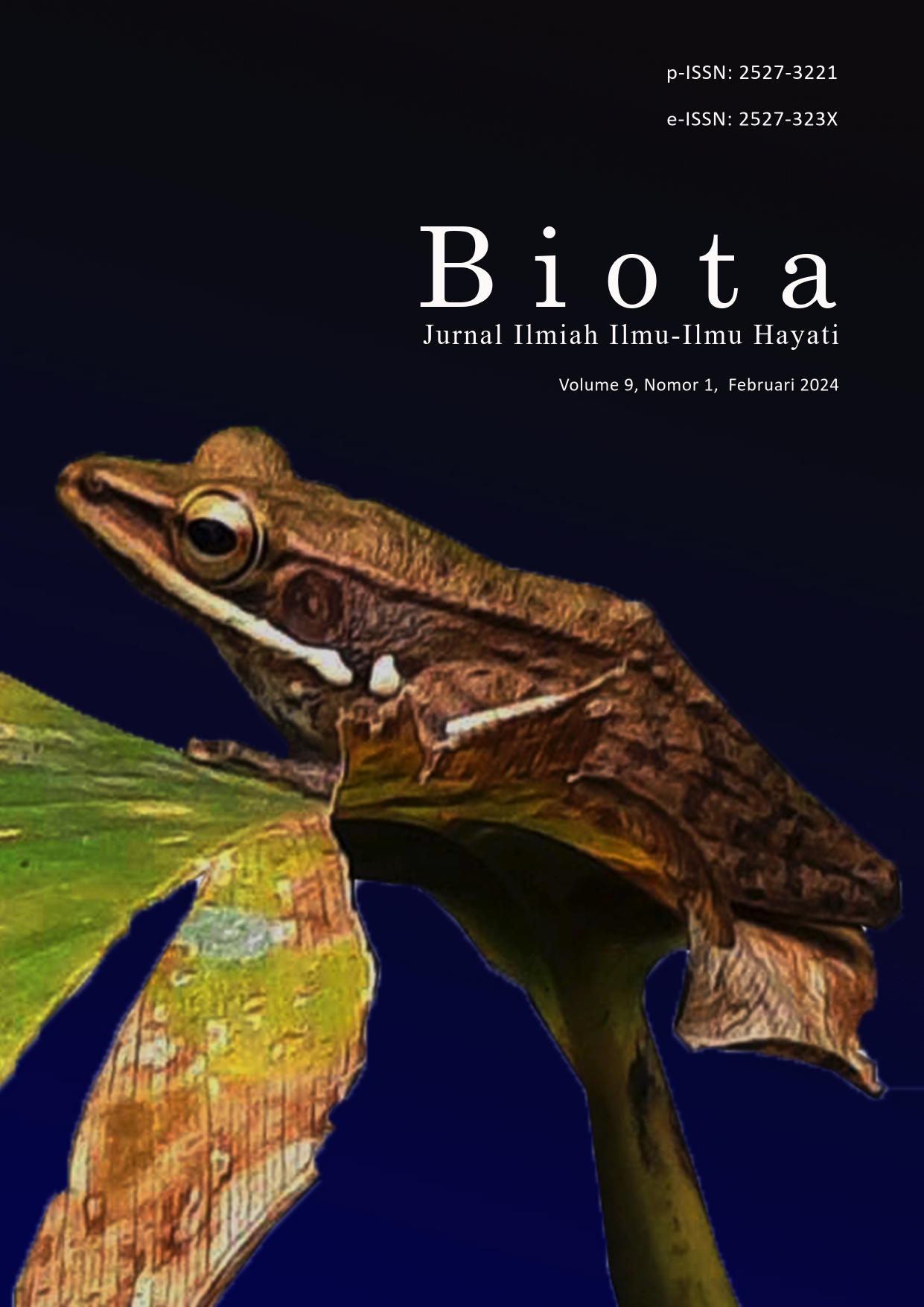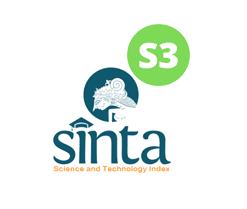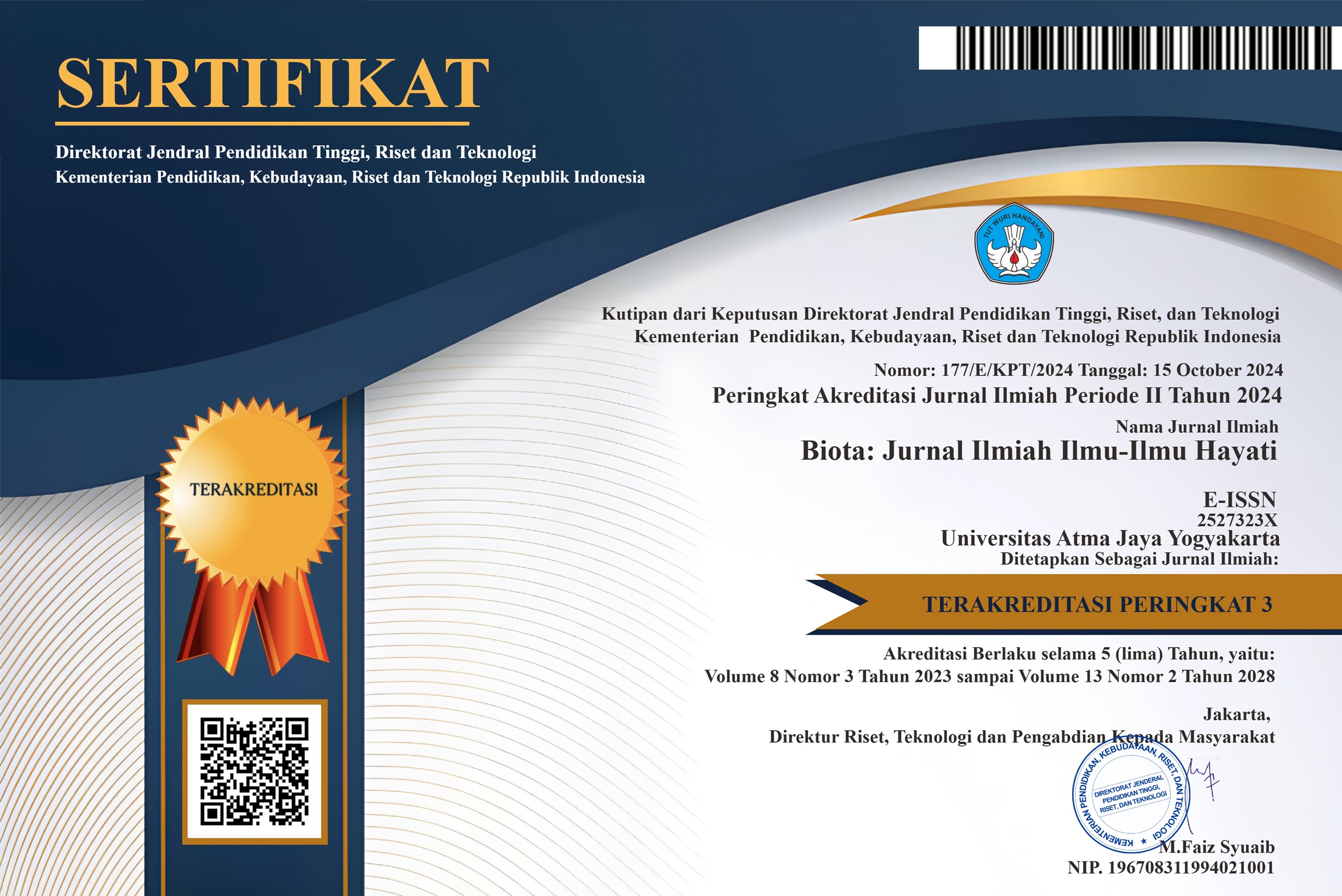The Aquatic Productivity using The Indicator of Plankton Diversity and Abundance in Telaga Dringo, Indonesia
DOI:
https://doi.org/10.24002/biota.v9i1.7497Keywords:
lake, primary productivity, secondary productivity, Telaga DringoAbstract
Aquatic productivity is the most basic trophic level in every aquatic ecosystem. Lake Dringo is a protected area and one of the highest lakes on the island of Java. Ecosystem balance can be seen from the study of water productivity. The purpose of this study was to determine the primary productivity and secondary productivity of waters in the Lake Dringo Nature Reserve, Central Java. The purposive sampling method was used in this study by establishing five stations and three replications at each station. The combination of primary and secondary productivity has a total abundance of 22,491-38,556 ind/liter. The highest abundance was Chlorophyta at 33% while the lowest abundance was Rotifera at 4%. This shows that there is no species dominance so that the primary productivity of the waters is still good.
References
Aldenberg, T. (2022). The limiting factor concept in relation to stability, sensitivity and bifurcation in plankton models. Dynamical Systems and Environmental Models, 196–208.
Anggara, A. P., Kartijono, N. E., & Bodijantoro, P. M. H. (2017). Keanekaragaman Plankton di Kawasan Cagar Alam Tlogo Dringo, Dataran Tinggi Dieng, Jawa Tengah. Indonesian Journal of Mathematics and Natural Sciences 40(2): 74-79.
Bramburger, A. J., Ozersky, T., Silsbe, G. M., Crawford, C. J., Olmanson, L. G., & Shchapov, K. (2022). The not-so-dead of winter: underwater light climate and primary productivity under snow and ice cover in inland lakes. Inland Waters.
Choi, Y., Oh, H. J., Lee, D. H., Jang, M. H., Lee, K. L., Chang, K. H., & Kim, H. W. (2023). Current Utilization and Further Application of Zooplankton Indices for Ecosystem Health Assessment of Lake Ecosystems. Sustainability 15(14): 10950.
Cotas, J., Gomes, L., Pacheco, D., & Pereira, L. (2023). Ecosystem Services Provided by Seaweeds. Hydrobiology 2(1): 75–96.
Florescu, L. I., Moldoveanu, M. M., Catană, R. D., Păces, I., Dumitrache, A., Gavrilidis, A. A., & Iojă, C. I. (2022). Assessing the effects of phytoplankton structure on zooplankton communities in different types of urban lakes. MDPI 14(3): 1-20.
Huo, S., Zhang, H., Wang, J., Chen, J., Environment, F. W.-S. of T. T. (2022). Temperature and precipitation dominates millennium changes of eukaryotic algal communities in Lake Yamzhog Yumco, Southern Tibetan Plateau. Elsevier. Retrieved from https://www.sciencedirect.com/science/article/pii/S0048969722017296.
Irigoien, X. (2019). Plankton: A Guide to Their Ecology and Monitoring for Water Quality 2nd edn. Retrieved from https://academic.oup.com/plankt/article-abstract/41/5/799/5573577.
Ji, S., Ren, S., Li, Y., Fang, J., Zhao, D., & Liu, J. (2022). The response of net primary productivity to climate change and its impact on hydrology in a water-limited agricultural basin. Environmental Science and Pollution Research 29(7): 10277–10290.
Kiørboe, T. (2019). Chapter Three. Diffusion and Advection. A Mechanistic Approach to Plankton Ecology, 35–56.
Mushet, G., & Reinhardt, E. (2022). The importance of effective moisture and landscape controls on diatom assemblages and primary production in Roche Lake, British Columbia, Canada over the past. Cambridge.Org 2023(111): 53-67.
Naselli-Flores, L., & Padisák, J. (2022). Ecosystem services provided by marine and freshwater phytoplankton. Hydrobiologia 2023(850): 2691-2706.
Noori, R., Woolway, R. I., Saari, M., Pulkkanen, M., & Kløve, B. (2022). Six decades of thermal change in a pristine lake situated north of the Arctic Circle. Wiley Online Library, 58(9).
Olson, C. (2022). Understanding Shifts in Limitation of Lake Primary Productivity Across Scales and Its Implications for Water Quality and Carbon Cycling. Retrieved from https://search.proquest.com/openview/a17fe7b9603b80c4ea3fccaf5ba5335d/1?pqorigsite=gscholar&cbl=18750&diss=y
Prowe, A. E. F., Su, B., Nejstgaard, J. C., & Schartau, M. (2022). Food web structure and intraguild predation affect ecosystem functioning in an established plankton model. Limnology and Oceanography 67(4): 843–855.
Puts, I. C., Ask, J., Siewert, M. B., Sponseller, R. A., Hessen, D. O., & Bergström, A. K. (2022). Landscape determinants of pelagic and benthic primary production in northern lakes. Global Change Biology 28(23): 7063–7077.
Rahayu, N., Hendarto, E., … I. S.-B. J. I. I., & 2020, undefined. (2020). Quantity of Coliform Bacteria as Bioindicator of Water Pollution (Case Study: Several Tributaries in Purwokerto City, Banyumas Regency, Central Java). Ojs.Uajy.Ac.Id 5(1): 42–47.
Rahayu, N., Lestari, W., Biologi, E. A.-M. I., & 2017, undefined. (n.d.). Bioprospektif Perairan Berdasarkan Produktivitas: Studi Kasus Estuari Sungai Serayu Cilacap, Indonesia. Journal.Bio.Unsoed.Ac.Id.
Reid, A. J., Carlson, A. K., Creed, I. F., Eliason, E. J., Gell, P. A., Johnson, P. T. J., Cooke, S. J. (2019). Emerging threats and persistent conservation challenges for freshwater biodiversity. Biological Reviews 94(3): 849–873
Ruthena, Y., Anggoro, S., & Soeprobowati, T. R. (2023). Diversity of Plankton Bio-indicators on Water Quality of Lutan Lake, Palangka Raya, Central Kalimantan, Indonesia. In E3S Web of Conferences 448: 03068.
Seekell, D. A., Lapierre, J. F., Ask, J., Bergstreom, A. K., Deininger, A., Rodriguez, P., & Karlsson, J. (2015). The influence of dissolved organic carbon on primary production in northern lakes. Limnology and Oceanography 60(4): 1276–1285.
Shi, J., Ni, L., Liu, J., Xu, C., Zhang, J., & Chen, X. (2023). Spatiotemporal distribution of phytoplankton community structure and its relationship with environmental factors in Hongze Lake, China. Urban Climate 52: 101746.
Sunil, S., Ojha, M., al., N. C. & Bhatt et, Bhatt (2022). Primary productivity and plankton diversity of Ana Sagar Lake in relation to fisheries potential. Researchgate.Net. Retrieved from https://www.researchgate.net/profile/NayanChouhan/publication/360515031_Primary_productivity_and_plankton_diversity_of_Ana_Sagar_Lake_in_relation_to_fisheries_potential/links/627b64a83a23744a7275c20e/Primary-productivity-and-plankton-diversity-of-Ana-Sagar-Lake-in-relation-to-fisheriespotential.pdf.
Suthers, I., Rissik, D., & Richardson, A. (2019). Plankton: A guide to their ecology and monitoring for water quality. Retrieved from https://www.google.com/books?hl=id&lr=&id=e8uPDwAAQBAJ&oi=fnd&pg=PP1&dq=Suthers,+I.+M.,+Richardson,+A.+J.,+%26+Rissik,+D.+(2019).+The+importance+of+plankton. Plankton:+A+Guide+to+Their+Ecology+and+Monitoring+for+Water+Quality,+1-13.&ots=FvRw9wZii5&sig=7Ji fgejq0_3SBrzPG25U7AkjZo.
Token, S., Jiang, L., Zhang, L., Conservation, G. L.-G. E. and, & 2022, undefined. (n.d.). Effects of plant diversity on primary productivity and community stability along soil water and salinity gradients. Elsevier. Retrieved from https://www.sciencedirect.com/science/article/pii/S235198942200097X.
Utami, A. (2022). Keanekaragaman Fitoplankton Sebagai Indikator Kesehatan Perairan di Waduk Cengklik. Retrieved from https://digilib.uns.ac.id/dokumen/download/90737/NTE5NjAy/Keanekaragaman-Fitoplankton-Sebagai-Indikator-Kesehatan-Perairan-di-Waduk-Cengklik-abstrak.pdf.
Wu, B., Dai, S., Wen, X., Qian, C., Luo, F., Xu, J., … 2022, undefined. (n.d.). Chlorophyll-nutrient relationship changes with lake type, season and small-bodied zooplankton in a set of subtropical shallow lakes. Elsevier. Retrieved from https://www.sciencedirect.com/science/article/pii/S1470160X22000425.
Yannawar, S., Akkewar, R., Yannawar, V., & Pedewad, S. (2022). Identification of freshwater zooplankton in Godavari River concerning food chain in aquatic ecosystem of Nanded, Maharashtra, India. Ijans.Org, 15(1), 1–14. Retrieved from https://ijans.org/index.php/ijans/article/view/545.
Yuan, Y., Jiang, M., Liu, X., Yu, H., Otte, M., Indicators, C. M.-E., & 2018, undefined. (n.d.). Environmental variables influencing phytoplankton communities in hydrologically connected aquatic habitats in the Lake Xingkai basin. Elsevier. Retrieved from https://www.sciencedirect.com/science/article/pii/S1470160X18302401.
Zahida, K., Hayati, I. Y.-B. J. I. I.-I., & 2018, undefined. (2018). Spesies Diversity and Abundance of Gastropods and Bivalves in Teluk Mekaki Beach Intertidal Zone, Sekotong, West Lombok. Ojs.Uajy.Ac.Id 3(3): 125–132.
Zhang, X., Yi, Y., Management, Z. Y.-J. of E., (2022). The long-term changes in food web structure and ecosystem functioning of a shallow lake: Implications for the lake management. Elsevier. Retrieved from https://www.sciencedirect.com/science/article/pii/S0301479721018661.
Downloads
Published
How to Cite
Issue
Section
License
Copyright (c) 2024 Nur Laila Rahayu, Endang Hilmi, Dewi Artini, Sisca Febrianti Listyaningrum, Rodrigo Tyas Perwira Widyatama, Anang Adri Ansah

This work is licensed under a Creative Commons Attribution-NonCommercial 4.0 International License.
Authors who publish with Biota : Jurnal Ilmiah Ilmu-Ilmu Hayati agree to the following terms:
- Authors retain copyright and grant the Biota : Jurnal Ilmiah Ilmu-Ilmu Hayati right of first publication. Licensed under a Creative Commons Attribution-NonCommercial 4.0 International License that allows others to share the work with an acknowledgment of the work's authorship and initial publication in this journal.
- Authors are able to enter into separate, additional contractual arrangements for the non-exclusive distribution of the journal's published version of the work (e.g., post it to an institutional repository or publish it in a book), with an acknowledgment of its initial publication in Biota : Jurnal Ilmiah Ilmu-Ilmu Hayati, and as long as Author is not used for commercial purposes.













